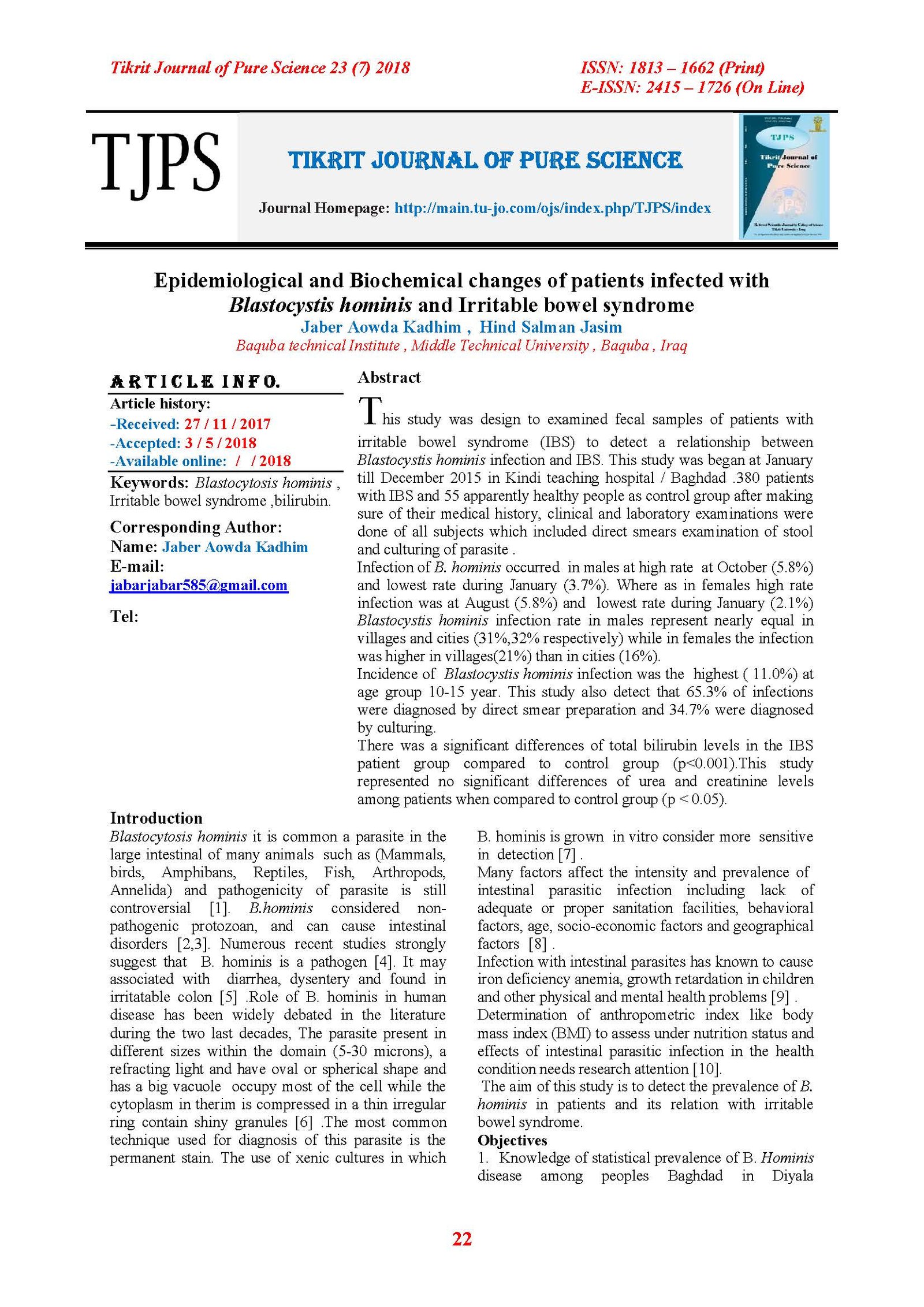Epidemiological and Biochemical changes of patients infected with Blastocystis hominis and Irritable bowel syndrome
Main Article Content
Abstract
This study was design to examined fecal samples of patients with irritable bowel syndrome (IBS) to detect a relationship between Blastocystis hominis infection and IBS. This study was began at January till December 2015 in Kindi teaching hospital / Baghdad .380 patients with IBS and 55 apparently healthy people as control group after making sure of their medical history, clinical and laboratory examinations were done of all subjects which included direct smears examination of stool and culturing of parasite .
Infection of B. hominis occurred in males at high rate at October (5.8%) and lowest rate during January (3.7%). Where as in females high rate infection was at August (5.8%) and lowest rate during January (2.1%) Blastocystis hominis infection rate in males represent nearly equal in villages and cities (31%,32% respectively) while in females the infection was higher in villages(21%) than in cities (16%).
Incidence of Blastocystis hominis infection was the highest ( 11.0%) at age group 10-15 year. This study also detect that 65.3% of infections were diagnosed by direct smear preparation and 34.7% were diagnosed by culturing.
There was a significant differences of total bilirubin levels in the IBS patient group compared to control group (p<0.001).This study represented no significant differences of urea and creatinine levels among patients when compared to control group (p ˂ 0.05).
Article Details

This work is licensed under a Creative Commons Attribution 4.0 International License.
Tikrit Journal of Pure Science is licensed under the Creative Commons Attribution 4.0 International License, which allows users to copy, create extracts, abstracts, and new works from the article, alter and revise the article, and make commercial use of the article (including reuse and/or resale of the article by commercial entities), provided the user gives appropriate credit (with a link to the formal publication through the relevant DOI), provides a link to the license, indicates if changes were made, and the licensor is not represented as endorsing the use made of the work. The authors hold the copyright for their published work on the Tikrit J. Pure Sci. website, while Tikrit J. Pure Sci. is responsible for appreciate citation of their work, which is released under CC-BY-4.0, enabling the unrestricted use, distribution, and reproduction of an article in any medium, provided that the original work is properly cited.
References
1. Zierdt CH. Blastocytosis hominis, a long misunderstood intestinal pathogen. Parasitol today 1988 ; 4 : 15-17 .
2. Stensvold C., Nielsen H., Molbak K., Smith H. "Pursuing the clinical significance of Blastocystis – diagnostic limitations". Trends Parasitol. 2009; 25 (1): 23–29
3. Silberman J.D., Sogin M.L., Leipe D.D., Clark C.G." Human parasite finds taxonomic home". Nature. 1996 ; 380 (6573) : 398. 4. Stark D, van Hal S, Marriott D, Elis J, Harkness J. "Irritable bowel syndrome: a review on the role of intestinal protozoa and the importance of their detection and diagnosis". Int. . Parasit. 2007; 37: 11–20. 5. Tungtrongchitr A , Manatsathit S, Kositchaiwat." Blastocystis hominis infection in irritable bowel syndrome patients". Southeast Asian J Trop Med Public Health. 2004 Sep ; 35 (3) : 705-10. 6. Zaman V, Howe J, Ng M. "Ultrastructure of Blastocystis hominis cysts". Parasit. Res. 1995;81 (6): 465–9 7. Leelayoova S, Taamasri P, Rangsin R, Naaglor T, Thathaisong U, Mungthin M. "In-vitro cultivation: a sensitive method for detecting Blastocystis hominis" . Ann. Trop. Med. Parasitol. 2002 ; 96 : 803 –807.
8. Battle C. Essentials of Public Health Biology. London: Jones and Bartlett Co, 2009; 286 -296
9. Cepon-Robins T, Liebert M, Gildner T, Urlacher S, Colehour A, Snodgrass J, Madimenos F, and Sugiyama L. "Soil-Transmitted Helminth Prevalence and Infection Intensity Among Geographically and Economically Distinct Shuar Communities in the Ecuadorian Amazon". J. l .Parasitol. 2014; 100 (5): 598-607
10. Ajayi MB, Sani AH, Ezeugwu SMC, Afocha EE, Adesesan AA ."Intestinal Parasitic Infection and Body Mass Index among School Children in Oshodi Lagos Nigeria". Adv Cytol. Pathol, 2017; 2 (2): 00015
11. Moe KT, Singh M, Howe J, et al.. "Observations on the ultra-structure and viability of the cystic stage of Blastocystis hominis from human feces". Parasit. Res. 1996 ; 82 (5) : 439 –44.
12. Block, Seymour Stanton. "Disinfection, sterilization, and preservation". Lippincott Williams and Wilkins; 2001: p 177.
13. Clark GC and Diamond LS. "Methods for cultivation of luminal parasitic protists of clinical importance". Clin. Micro. Rev. 2002 :15 (3) . 329 -41.
14. Burtis CA.,. Ashwood ER and Bruns DE(eds): Tietz Fundamentals of Clinical Chemistry (6th edition). Saunders Elsevier, St. Louis, USA,2007.
15. Leelayoova S, Taamasri P, Rangsin R,. "In-vitro cultiva-tion: a sensitive method for detecting Blastocystis hominis". Ann Trop Med Parasitol 2002 ; 96: 803-7.
16. Omar M. The Epidimiology of Blastocytosis hominis in USA. Res. J. parasit. 2006: 1(1):1-1.
17. Nimri L. and Raymond B. "Intestinal colonization of symptomatic and asymptomatic schoolchildren with Blastocytosis hominis ". J. Clin. Microbio. 1994: 2865-66.
18. Guimaraes,'S., and M. I. L. Sogayar. "Blastocystis hominis: occurrence in children and staff members of municipal day care centers from Botucatu, Sao Paulo State, Brazil". Mem. Inst. Oswaldo Cruz. 1993: 88:427-429.
19. Stenzel DJ, Boreham PF." Blastocystis hominis revisited". Clin Microbiol Rev 1996; 9: 563-84
20. Herbert J Santos, Windell L Rivera. "Comparison of direct fecal smear microscopy, culture, and polymerase chain reaction for the detection of Blastocystosis in human stool samples". Asian Paci. J. of Tropi. Medic. 2013: 780-784. 21.Yukihiro Sh. "Liver in systemic disease". World J. of Gastroenterology. 2008: 14 (26):4111-9. · 22. Todd S. Perlstein, Reena L. Pande, Joshua A , Mark A. Creager.Serum Total Bilirubin Level and Prevalent Lower Extremity Peripheral Arterial Disease. Arterioscler Thromb Vasc Biol. 2008 : 1-7. 23. Nassir ,J. Awa, A. B. Abel, Shay M, Lejbkowicz F. "Blastocystis hominis as a cause of hypoalbuminemia and anasarca. Eur. J. Clin. Microbio. Infect. Dis. 2004, 23(5), 399–402.
